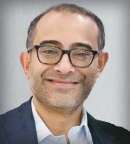Upal Basu Roy, PhD, MPH, Executive Director of Research at the LUNGevity Foundation, in Chicago, shared his thoughts with The ASCO Post on the INCREASE trial’s findings and their potential impact on clinical practice.
As Dr. Roy explained, neoadjuvant chemoimmunotherapy remains the current standard for patients with non–small cell lung cancer, whose tumors are operable. In this group, use of neoadjuvant chemoimmunotherapy leads to a pathologic complete response of 24%. Conversely, in patients whose tumors are borderline operable (ie, larger in size with spread to the chest wall), chemoradiation is often used before surgery. In this group, said Dr. Roy, pathologic complete response never seems to exceed 35%.

Upal Basu Roy, PhD, MPH
The INCREASE trial team combined immunotherapy with chemoradiation to see whether this combination would be beneficial to patients with borderline-operable tumors, said Dr. Roy. The INCREASE trial regimen led to doubling of the pathologic complete response rate at 60% coupled with R0 resections.
“These findings are definitely promising, given that treatment-related toxicities were manageable,” said Dr. Roy, who noted the trial team had access to a multidisciplinary team that evaluated each patient. “The [trial team] also integrated early palliative care (physiotherapy, access to a dietician, and use of antibiotics to avoid postoperative infections), highlighting the fact that palliative care incorporation has a positive impact on patient outcomes.”
Questions Remain
According to Dr. Roy, however, there are still remaining questions. The sample size of the study is relatively small and is also restricted to a large institution in the Netherlands, for example.
“Data from longer follow-up of the INCREASE trial patients and a potential larger trial, coupled with access to a multidisciplinary board, will be the major determinants of whether these findings will drive practice change,” Dr. Roy concluded.
DISCLOSURE: Dr. Roy reported no conflicts of interest.

